- Home
- Michael Newton
How to Write Action Adventure Novels Page 13
How to Write Action Adventure Novels Read online
Page 13
The use of dialects and accents may be useful in establishing your characters—but it can also blow up in your face, unless you’re careful. Cousin Timmy’s fretting over pore ole Aunt Cecilia, livin’ by her lonesome in the holler? Good for him. But bear in mind that unfamiliar dialects, when overused, have a potential for confusing readers. Worse, if the colloquial expressions overlap your mainstream narrative, outside established dialogue, the author may begin to seem illiterate. Don’t have your people runnin’, jumpin’, and the like, in mainstream narrative unless the point of view has clearly been established for a character who would think in those terms. (Be cautious, all the same. Editors are prone to have even their illiterate characters think in proper English.)
Expletives Deleted?
Obscenity goes hand-in-hand with dialect and slang. There are no rules, per se, about insertion of profanity in dialogue, but tiresome repetition of “the F word” and its cousins can be self-defeating for a writer. Hard-core language is, ideally, used to make a point: to shock, surprise, or have some other predetermined impact on your readers. Well-timed expletives, evoked from characters who otherwise would never let such language pass their lips, can have a powerful effect in dialogue. But if we’ve grown accustomed to the use of “fucking” this and “frigging” that in every other line, what happens to the impact? Pfft! It’s gone.
I dare say most of us know real-life individuals who can’t complete a sentence, let alone a paragraph, without resorting to certain pet obscenities. Are any of them really interesting? No? So, why should your prospective readers care to take them home, and pay you for the privilege, at that? Keep your swear words sparse and they’ll gain impact.
But don’t shy away from blunt language, either. Action heroes don’t say “Drat”; vicious terrorists don’t scream “Phooey!” Although sexist and racist slurs should be avoided, it’s natural that the occasional four-letter word will slip out in the heat of battle. Either use the word or else cut profanity and obscenity altogether: accept no substitutes.
When fledgling authors strive for color and variety in dialogue, they sometimes run afoul of misused “onomatopoeia” (words that imitate the sounds they describe). Action scenes are frequently enlivened with the clang of steel on steel, the buzz of insects, or the crack of rifle fire. It works, but writers sometimes lose control as characters begin to grunt, groan, snap, and snarl in lieu of simply saying what is on their minds. The curse of misused onomatopoeia strikes when careless writers fasten on a catchy verb without regard to its appropriate employment in the text.
“Get out!” he hissed.
Perhaps, but I’m inclined to doubt it. Hissing deals with sibilance, the airy, lisping sound that we associate most commonly with serpents in the grass. “Get out!” has none of that, and “hissed,” therefore, is badly out of place as a description of the utterance.
“She stole my wallet,” Tommy moaned.
Not likely. Moaning is a sound of pain, and normally an inarticulate response to pain, at that. I question whether any sentence can be moaned, and clearly, the example cited does not fit the bill.
“I thought you might forget your flashlight,” Amy chuckled, “so I brought an extra.”
Can you really picture anybody chuckling a twelve-word sentence? They would certainly be incoherent, and might well be taken for a mental patient out on furlough. Either way, the author’s choice of verbs is ill-advised. Before you wax poetic in your dialogue, be sure your phrase of preference makes sense in context. Otherwise, your readers may be chuckling when you expect them to be hissing—and the laugh will be on you.
We’ve already dealt with the desirability of avoiding stereotypical characters, but the message bears repeating here, in reference to dialogue. Dramatic conversations are a vital part of character depiction; you should exercise restraint in use of “ethnic” dialects and accents, which may jeopardize an otherwise dynamic character, transforming him or her into a tired cliché.
Clichés Revisited
A character who happens to be black and earns a million dollars yearly will not talk like Stepin Fetchit in a movie from the 1920s. “I’se gwan home now, suh,” won’t make it anymore. Hispanics may occasionally sound like Cheech and Chong in concert—”Man, tha’s some charp car joo got dere”—but for every one who does, there are a dozen who do not. I seriously doubt that any Native Americans have referred to “white man speaking with forked tongue” in recent years, and woe to any author who depicts a leader of the Yakuza buying “rorrypops” for his children, sipping “chelly Coke,” or rushing home from work to see his “Mama-san.” If your ethnic sensitivity extends no further than your bank book, bear in mind that you cannot predict the nationality or background of prospective editors and publishers. If you offend them going in, you’re out of work.
Sexual clichés are also tacky, though your average action editor is quicker to forgive depiction of a fluffy female airhead than he would be an attack on Blacks or Jews. Remember, please, that while your basic macho man is still a staple of the genre, your protagonist is not required to be a neolithic chauvinist. Examine, if you dare, the suave technique of J. C. Stonewall, Soldier for Hire, as he puts his move on “the only white woman in Singapore”:
‘You’re a gorgeous broad, Audry. And I simply wanted to buy you a glass of champagne.”
“And?”
He shrugged. “And take you out to a late supper and then to bed.”
The lady’s response? What else? She heads for the nearest hotel room, drops her clothes and cries, “You are the stuff of my dreams, J. C. Hurry, fill me with that enormous phallus before I lose my cookies right here.”
Heard enough? I thought so. Never mind the critical dissection of a scene like this. The best that it deserves is speedy burial. In an apparent effort to fulfill some adolescent fantasy, the author makes his characters—and then himself—look foolish in a classic case of lazy, heavy-handed writing. (And what writing! Last time I heard someone say they were about to “lose their cookies,” they were suffering from nausea. In Audry”s case, it must be shock induced by that “enormous phallus.”)
On the distaff side, I realize that women, for the most part, still play second string in action novels, but they are increasingly portrayed as levelheaded, competent professionals. The ladies aren’t just pretty airheads anymore, and women who display a competence with weapons or computers needn’t be portrayed as lesbians or frigid spinsters, either. On the other hand, despite the harsh realities of life around the U.S. Embassy in Moscow, female agents are not universally required to put their bodies on the line for every mission they accept. The luscious agent sleeping with a mobster/commie/Nazi/terrorist for information has been done to death; it may have uses, now and then, but it deserves a rest.
The Author as a “Silent Partner”
It’s tempting, sometimes, to employ your characters as spokesmen for your own philosophy. Most authors tip their hands from time to time through dialogue, a passing comment, their depiction of a character. It’s natural, and it shouldn’t be a problem if you exercise a little self-restraint. We hit a snag when propaganda takes the place of fiction, and the author’s personality distorts his story line. As noted earlier, it’s fine to let a racist character express himself through dialogue, as long as readers understand he doesn’t speak for you. When the distinction is obliterated, you’ve got problems on your hands.
Let’s take another look at J. C. Stonewall, brainchild of author Mark Roberts in the now-defunct Soldier for Hire series. The ultimate chauvinist, Stonewall is also a pathological red-baiter, incessantly cursing New York liberals (i.e., Jews), gun-control advocates, and “those fuckin’ rag- heads in Iran.” At one point, after nearly drowning, Stonewall rails against the sea for its temerity in trying to stop him “from killing more commies.” His personal bogeyman is “Senator Ned Flannery,” a transparent stand-in for a well-known eastern politician, as depicted in the following excerpt from Jakarta Coup (Zebra, 1983):
�
��At least he won’t be running for president,” Theo observed. “Don’t fucking count on it,” Stonewall snapped. “He said the same thing last time, then campaigned like mad for it. It was the same old shit four years before that. He’s just angling to get the loyal party hacks to beg him to take the nomination.”
“The Flannerys do seem to think they are the rightful pretenders to the throne of North America,” Ed allowed.
‘Yeah. King Ned the First,” Stonewall shot back. “King of the sewer rats if you ask me.”
A browse through any novel in the Stonewall series makes it obvious that J. C., by and large, is speaking on behalf of his creator. It gets tiresome in a hurry, and an author who insists on lecturing his readers in the guise of fiction should prepare himself for ultimate (and well-deserved) rejection in the marketplace.
Politically, adventure fans are normally conservative. That doesn’t mean, however, that your readers are a pack of hard-core, neo-Nazi morons. If your novels come off sounding like the latest issue of The Fiery Cross, you have a problem on your hands. As Stephen King has aptly stated, “It’s the tale, not he who tells it.”
Decent dialogue, in short, is crucial to development of characters and to advancement of a story. If perfection of technique requires some sweat in the beginning, you should find it worth your time and effort in the end. It’s not enough, however, for your characters to simply walk and talk. In action novels, there is always dirty work afoot, and having come this far, it’s time to brace yourself for fighting fire with fire.
9. “Gunpowder Orgies”
Wherever genre publishing is open to debate, the “sex-and-violence problem” rears its ugly head. Like gun control or the women’s movement, it raises hackles, sparking angry diatribes from “intellectuals” who fail to recognize a phony issue when they see one. Still, the genre and its authors take a lot of flack for their alleged promotion of a sexist, trigger-happy atmosphere in the United States, and no discussion of the genre is complete without a look behind the florid rhetoric.
The general tone for critical response to action novels was established in the early 1970s by a review in New Republic. Dishing up a survey of the field, then ruled by Pinnacle, the author took a clumsy stab at social criticism, lumping various genre entries together as “gunpowder orgies.” A decade later, SMU Professor William Gibson still bemoans the presence of a “paramilitary culture” in America, sustained by literature he describes as “cheap, formula written and erotic.” Interviewed by the Chicago Tribune (August 27, 1987), Gibson set his sights on action heroes, offering the sage opinion that “Sex is not far from their violence.”
Enough, already. If you’ve heard one critic blast the genre, you have literally heard them all. This book is not the place to argue psychiatric theories of the gun as phallic symbol, and I will not bore you with my personal opinions of the self-appointed censors who insist on blaming television, books, and movies for the actions of assorted violent misfits. Let’s just say that murder, rape, and torture were “invented” long before the printing press, the movie camera, or the VCR, and I suspect these pastimes will endure when technology has turned another page. The fact is, sex and violence do exist in genre fiction, and if you pursue your interest in the field, you will inevitably have to deal with both.
More Mayhem, Please
For starters, we must realize that “action” and “adventure” are not necessarily synonymous. A reference to “action” currently implies a fair amount of violence, often lethal, frequently described in graphic terms. If you’re uncomfortable with the idea of killing people on paper, you should seriously think about some other field of fiction where you won’t be forced to deal with violence so directly.
Readers in the action genre come prepared to cope with sex and violence, but their personal responses vary widely. A New Jersey woman in her twenties writes Gold Eagle, publishers of The Executioner, that she’s “pleased that sex is kept to a minimum in this action-adventure series.” A man in his sixties complains that action novels “don’t need such graphic descriptions of the effect of bullets and knives.” On the flip side, a teenage boy laments that there’s “not enough violence” in recent offerings, and a female reader in her late sixties echoes his complaint. “There was not enough VIOLENCE,” she writes. “Add more descriptions of wounds!”
Which brings us to the classic question: How much violence is too much? Is violent content to be judged by graphic scenes, or on the basis of accumulated body-counts? And who decides?
There is a world of difference between the splatter novels, typified by Jack Ketcham’s Off Season, and more restrained offerings like Tom Harris’s Red Dragon, where most of the violence is implied (or at least spared graphic depiction). Both styles have their followings, and I believe both authors are sincere in their attempts to entertain a given audience. The ultimate selection of a style for handling violence will depend, in fairly equal measure, on the author’s private taste and on his editor’s discretion.
Unless your contract grants you editorial approval—and it won’t, unless your prior sales have placed you in the tiny “household name” fraternity of million-selling authors—final content of your novels will be thrashed out by the editors, who rule on everything from general themes to the specific punctuation marks and choice of language in a given snatch of dialogue. Occasionally, editors may wish to punch up a sluggish story by adding further action scenes—and some still cherish quotas that demand a given quantity of violence per manuscript—but more are likely to concern themselves with the varieties and specificity of mayhem than its frequency.
Gold Eagle’s editors maintain a policy of toning down (or cutting out) sadistic torture scenes, and they are not alone. Deletion of repulsive violence strikes the great and small alike, as shown by Stephen King in Danse Macabre (Everest House, 1981), when he discusses the strategic use of hungry rats:
Actually, I used them to create a scene so revolting that my editor suggested strongly that I remove it and substitute something else. After some grousing, I complied with his wishes. In the Doubleday/New American Library editions of ’Salem’s Lot, Jimmy Cody, a local doctor, and Mark Petrie, the boy accompanying him, discover that the king vampire—to use Van Helsing’s pungent term—is almost certainly denning in the basement of the local boarding house. Jimmy begins to go downstairs, but the stairs have been cut away and the floor beneath littered with knives pounded through boards. Jimmy Cody dies impaled upon these knives in a scene of what I would call “horror”—as opposed to “terror” or “revulsion,” the scene is a middle-of-the-roader.
In the first draft manuscript, however, I had Jimmy go down the stairs and discover—too late—that Barlow had called all the rats from the dump to the cellar of Eva Miller’s boarding house. There was a regular Hojo for rats down there, and Jimmy Cody became the main course. They attacked Jimmy in the hundreds, and we are treated (if that is the word) to a picture of the good doctor struggling back up the stairs, covered with rats. They are down his shirt, crawling in his hair, biting his neck and arms. When he opens his mouth to yell Mark a warning, one of them runs into his mouth and lodges there, squirming.
I was delighted with the scene as written because it gave me a chance to combine Dracula-lore and E.C.-lore into one. My editor felt that it was, to put it frankly, out to lunch, and I was eventually persuaded to see it his way. Perhaps he was even right.
Ego aside, they usually are. If editors tone down your violence, they probably have some reason other than personal squeamishness—i.e., company policy, or an aversion to offending their readers with gratuitous gore and sadism. It may smart a bit when your pet scenes are trimmed to the bone, but remember the editor shares your responsibility for producing a polished, quality book.
Killing ’em Softly
Stylistic handling of violence varies with the personality of each and every writer in the business. Savvy authors realize it pays to give their readers some variety, adopting different angles of attack from t
ime to time. Examine how Tom Harris leaves the killing carefully off stage in this example from Black Sunday:
Number 18 Rue Verdun was guarded round the clock. One sentry was stationed in the foyer, and another armed with a machine gun watched from the roof of the building across the street. Now the rooftop sentry lay in a curious attitude behind his gun, his throat smiling wetly in the moonlight. The sentry from the foyer lay outside the door where he had gone to investigate a drunken lullaby.
But Harris can explode, when mayhem is required, as in Red Dragon, when we see the last of killer Francis Dolarhyde:
She forgot the stance and she forgot the front sight but she got a good two-handed grip on the pistol and as the door exploded inward she blew a rat hole through his thigh—“Muhner!”—and she shot him in the face as he slid down the door facing and she shot him in the face as he sat on the floor and she ran to him and shot him twice in the face as he sprawled against the wall, scalp down to his chin and his hair on fire.
Don Pendleton is another author well versed in the variations of violent delivery. Examples of the “hard” and “soft” approach are found within a dozen pages of each other in his novel Nightmare in New York. We meet the Executioner as he discovers that a female ally has been tortured by the mob:
He stepped jerkily to the table and gazed down upon what was left of Evie Clifford. The dead eyes stared back at him. They had to. The eyelids had been sliced away. And even through the coagulated blood that was brimming those horrified sockets Bolan could see the agony and the accusation and the mirror of his own guilt and neglect.

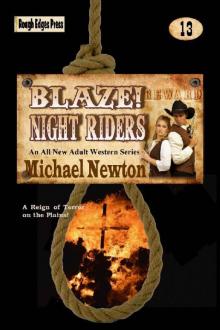 Blaze! Night Riders
Blaze! Night Riders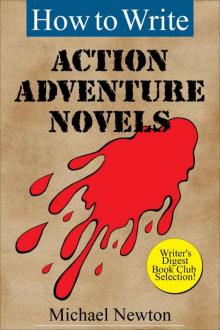 How to Write Action Adventure Novels
How to Write Action Adventure Novels Blaze! Bad Medicine
Blaze! Bad Medicine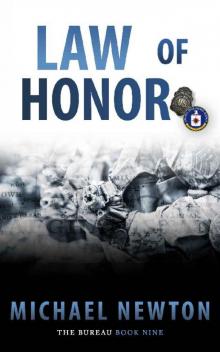 Law of Honor
Law of Honor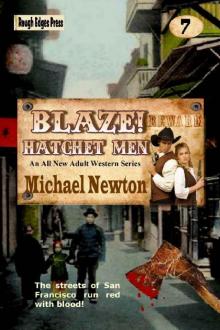 Blaze! Hatchet Men
Blaze! Hatchet Men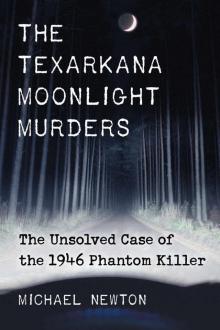 The Texarkana Moonlight Murders
The Texarkana Moonlight Murders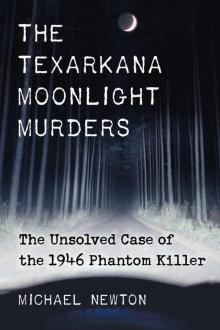 The Texarkana Moonlight Murders: The Unsolved Case of the 1946 Phantom Killer
The Texarkana Moonlight Murders: The Unsolved Case of the 1946 Phantom Killer